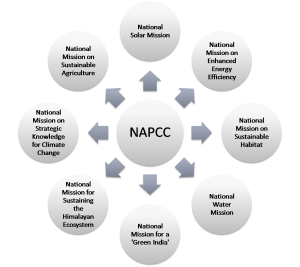
Climate Change
- It is the long term change in the statistical distribution of weather patterns over periods of time
- Though it has been happening naturally for millions of years, in recent years it has accelerated due to anthropogenic causes and has been causing global warming.
- UNFCCC defines climate change as – “a change of climate which is attributed directly or indirectly to human activity that alters the composition of the global atmosphere and which is in addition to natural climate variability observed over comparable time periods”
During the last decades of urbanization,industrialization and population growth the atmosphere has been polluted. Human activities increase the amount of carbon dioxide, Chloro Floro Carbon (CFC) and other dangerous gases. About 51% of the solar energy is absorbed by the earth’s surface, which increases its temperature. The rest of the heat is reflected back in to the atmosphere. This helped in maintaining temperature. But now due to pollution some of the reflected heat is trapped by green house gases (GHGs), mainly carbon dioxide. It has increased the temperature of the Earth’s surface. There is evidence to show that CO2 levels are still increasing. Many countries have signed a convention to reduce GHGs under the U.N. framework. However, the current international agreements are still not effective enough to prevent the significant changes in climate.
Global Warming
- An increase in the average temperature of Earth’s near surface air and oceans since the mid-20th century
- 4th assessment report of IPCC: global temperature increased 74+0.18 degree C during the 20th century.
- Caused by greenhouse gases
- Water vapour, Co2, Methane, Nitrous Oxide, Ozone, CFCs (in order of abundance)
- Since the industrial revolution, the burning of fossil fuels has increased the levels of Co2 in the atmosphere from 280 ppm to 390 ppm.
There is lots of evidence that tells us the average temperatures of the world’s atmosphere and oceans have increased over the past 150 years.
The evidence includes:
- direct temperature measurements on land
- changes in the dates when lakes and rivers freeze and their ice melts
- a reduction in the extent of snow cover in the Northern Hemisphere
- a reduction in glaciers
- extended growing seasons of plants
- changes in the heat stored in the ocean
- changes in rainfall patterns resulting in more floods, droughts and intense rain.
A number of biological changes have also been observed.
These include:
- shifts in the ranges of some plant and animal species
- earlier timing of spring events such as leaf-unfolding, bird migration and egg-laying for some species.
Together these indicators provide clear evidence that the climate is changing.
Climate Change Mitigation
- Alternative Energy sources
- Renewable energy
- Nuclear Power
- Reduce the carbon intensity of fossil fuels
- Energy efficiency and conservation
- Transport and urban planning
- Building design
- Reforestation and avoid deforestation
- Eliminating waste methane
- Geoengineering
- Greenhouse gas remediation
- Biomass
- Carbon air capture
- Carbon capture and storage
- Societal control
- Population
- Sustainable life-style
- Greenhouse gas remediation
The potential
impacts of climate change are often diverse and the immediate need to address these adverse impacts is widely recognized. Similarly, different regions have differential vulnerabilities to climate change, therefore different approaches need to be applied that are context and regionspecific. While traditionally, climate change experts have focused on mitigation measures, adaptation measures have also been acknowledged of late as effective and equitable means to deal with climate change impacts. Most of the mitigation measures are high in terms of technology and capital. Therefore, while developed economies choose to mitigate climate change by making heavy investments, developing economies choose to adapt. However, allocating responsibilities for mitigation is a complex task and involves international negotiations. It has been increasingly recognized that a joint approach addressing the issues of adaptation and mitigation together is the most appropriate one for countries like India. Following are the Eight Missions of India’s National Action Plan on Climate Change:-- National Solar Mission Seeks to deploy 20,000 MW of solar electricity capacity in the country by 2020. The first phase (2010-12) is currently underway during which 1000 MW is planned to be installed.
- National Mission for Enhanced Energy EfficiencyCreates new institutional mechanisms to enable the development and Energy Efficiency strengthening of energy efficiency markets. Various programmes have been initiated, including the PAT mechanism to promote efficiency in large industries, and the Super-Efficient Equipment Programme (SEEP) to accelerate the introduction of deployment of super-efficient appliances.
- National Mission on Sustainable Habitat Promotes the introduction of sustainable transport, energy-efficient buildings, Sustainable Habitat and sustainable waste management in cities.
- National Water Mission Promotes the integrated management of water resources and increase of Mission water use efficiency by 20 per cent.
- National Mission for Sustaining the Himalayan Ecosystem Establishes an observational and monitoring network for the Himalayan the Himalayan Ecosystem environment so as to assess climate impacts on the Himalayan glaciers and promote community-based management of these ecosystems
- National Mission for Green India Seeks to afforest an additional 10 million hectare of forest lands, wastelands and community lands.
- National Mission for Sustainable Agriculture Focuses on enhancing productivity and resilience of agriculture so as to reduce vulnerability to extremes of weather, long dry spells, flooding, and variable moisture availability.
- National Mission on Strategic Knowledge for Climate Change Identifies challenges arising from climate change, promotes the development Knowledge on Climate Change and diffusion of knowledge on responses to these challenges in the areas of health, demography, migration, and livelihood of coastal communities.
- MPPCS Mains 2025 Tests and Notes Program
- MPPCS Prelims Exam 2025- Test Series and Notes Program
- MPPCS Prelims and Mains 2025 Tests Series and Notes Program
- MPPCS Detailed Complete Prelims Notes 2025
